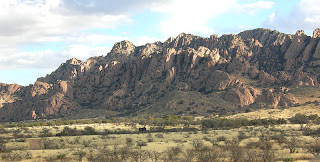 |
| Dragoon Mountains, photo courtesy Wilson44691 |
The Apache Indians struggled over decades and even centuries against invaders of their southwest territory. First, the Spaniards traveled through what is now Arizona starting with Coronado's 1540 Expedition in search of the seven Cities of Cibola. Coronado was looking for the famed cities of gold which had been talked about by the Aztecs further south in New Spain or present day Mexico.
The Spaniards of course among other things established missions for the purpose of converting the Native population to Christianity. In fact, the missions in both New Mexico and Arizona, some of which are still in use today, were built years before Fray Junipero Serra built the first California mission in present day San Diego.
After the Spaniards were expelled from the North American continent during the Mexican Revolution of the early 1820's, the Apaches now had a new adversary. The Apaches carried their campaign against the Mexicans across the borders into northern Mexico. The new Mexican Government carried out similar campaigns against the Apaches. All of this was relatively over a short time since the Mexicans literally lost the territory to the Americans as a direct result of the 1848 Mexican-American War resolution. Now the question was..how would the Apaches and Americans get along? It didn't take too long to find out.
Some historians contend that the Apache conflicts with the Americans lasted from 1851 to 1906. Some contend that the conflicts with settlers started in 1847 during the time of the Mexican-American War and the Taos Revolt. The first United States military campaigns against the Apache began in 1851 and the last major one would end with the surrender of Geronimo at Skeleton Canyon New Mexico in 1886. Between this span of 35 years is what many believe was the real Apache War. Still others contend that the hottest part of the war was the period between 1861 (when Cochise became involved) until the 1886 Geronimo surrender. Many thus feel that the Apache War as we know it was a 25 year affair..still a very long time.
In 1861, Cochise was thought to supply fire wood to the Butterfield Stage Line station at Apache Pass Arizona. The uprising that had begun in 1861 was a result of what is known as the "Bascom Affair". The Bascom Affair was something that could possibly have been avoided and included some questionable decision making by a young cavalry officer. Indian parties were raiding cattle ranches and the military was called in from Fort Apache. Cochise was caught up in the middle of it and it became a standoff that just kept escalating out of control. To give you an idea of the violence of the Apache War, a portion of the Butterfield Stage route from Bowie to Tucson ran nearby the Dragoon Mountains, Cochise's stronghold, and over a period of some 16 months Cochise's warriors killed 22 stage drivers. As you can see from the Butterfield route map above, the line to California went through the heart of the Apache territory in what is now southern Arizona. Some historians feel that the Bascom Affair ignited a 25 year Apache Indian War in Arizona that crossed over the border into Mexico before it ended with Geronimo's surrender at Skeleton Canyon in what is now New Mexico.
Cochise was captured and escaped several times. He evaded capture and continued to raid white settlements up until 1872. At that point a treaty was signed with the military and with the help of Tom Jeffords who was the only white friend of the chief. Cochise, born in 1805, then went into retirement on the Apache Reservation and died in 1874 of natural causes. He was reported to be buried in or near the Dragoon Mountains north of Tombstone AZ.
So, the question is, where can the tourist or history minded traveler find memorials and more information about Cochise? The Cochise Stronghold Indian Museum in Cochise Arizona, an unincorporated town in Cochise County. On a historical note, Big Nosed Kate who owned a popular saloon in Tombstone and confidant of Doc Holliday resided in Cochise while she was working at the Cochise Hotel after Holliday's death. Cochise is located on Hwy 191 about 4 miles south of Interstate-10 in southern Arizona. Cochise AZ is also about 40 miles northeast of Tombstone. It's a good combination road trip with both Tombstone and Bisbee Arizona.
Another interesting stop for the outdoors enthusiast is the Cochise Stronghold Park. It offers many hiking trails which range from easy to strenuous, and features the popular Stronghold Nature Trail. At just under half a mile, the easy trail is an adventure of the senses. Cochise Stronghold is located in the Coronado National Forest. Day-use or camping fees may apply.
The Chiricahua National Monument is also called "the land of standing-up rocks" by the Apaches. It's said that this 12,000 acre monument contains some of the earth's most startling rock formations. The Monument is an excellent hiking and birding area. Be certain to bring your camera for some terrific photo ops. The area is 36 miles southeast of Willcox Arizona. Exit Interstate-10 at Willcox and take Hwy 186. The monument is about 75 miles east of Tucson and just south of Interstate-10.


